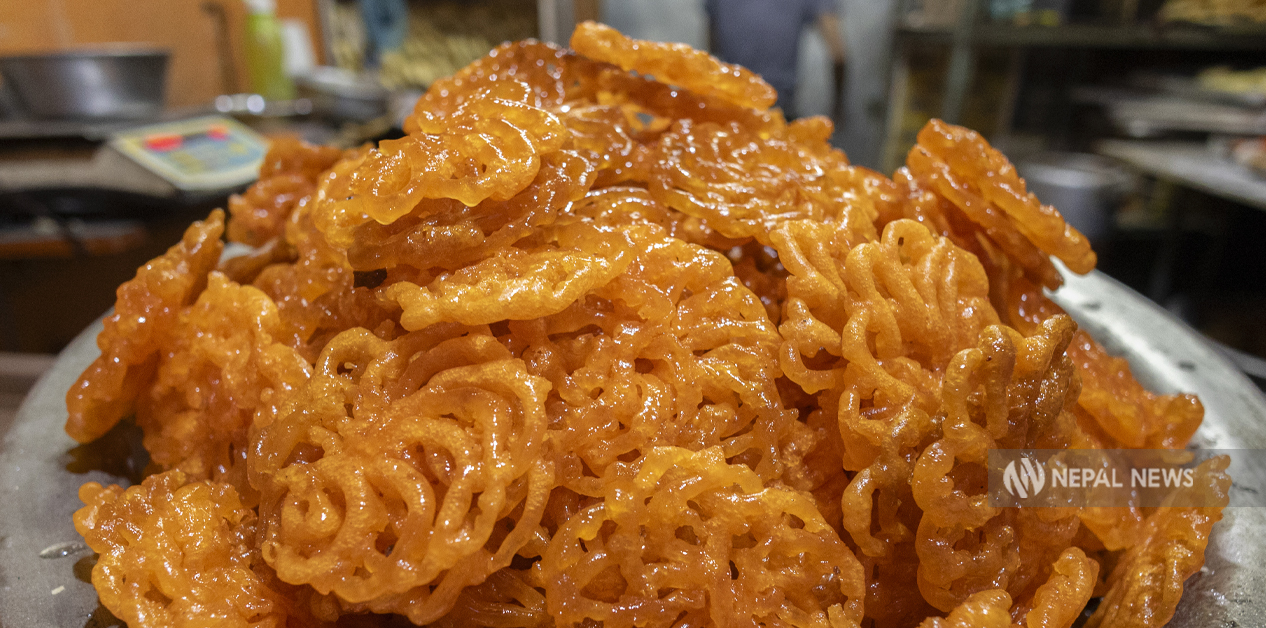

SIRAHA: “It’s Langlati. It’s very delicious, made with khuwa (a dense, unsweetened dairy food made by boiling milk and reducing it until the moisture evaporates, leaving a solid mass of milk solids),” insisted Ashok Yadav, a social worker from Siraha. It hadn’t been long since the author had a full meal in Siraha Bazaar of Madhes. As the author prepared to leave after a thirty- or forty-five-minute meeting, Ashok’s kind heart couldn’t allow it.
“It is hot, and the journey is long. Please have some curd and then go,” it was understood that the Madhes host’s hospitality would not be denied. He drove the car all the way to Gulariya, Siraha. This place, once dangerous to walk alone in, is becoming lively, and a particular shop for curd, lassi (a traditional curd-based drink), and sweets has blossomed there. Like a resting place for travelers coming toward Siraha from the North or from Choharba, everyone stops once, eats curd and lassi, and then continues on their way.
When the curd tasted a bit sour, Ashok ordered Langlati, which the author tried for the first time. The taste of the seemingly simple sweet, served on a piece of newspaper, was extraordinary.
Langlati, or Langlatta, is not commonly seen even in the sweet shops of Madhes markets, let alone in Kathmandu. When outsiders visit Madhes, they typically eat puri, sabji (curry made with potatoes and grams), and jalebi or jeri (a popular sweet from South Asia, made by frying a fermented batter into a crisp, coiled shape and then soaking it in warm sugar syrup) for breakfast. These shops generally stock common sweets like jeri or jalebi and laddu-peda. Although Langlati is considered a sweet that came from across the border a bit later, it cannot change its color like jalebi. The color of jalebi is also interesting; in city shops, they are made a light golden to show that they are pure, having been deep-fried in ghee and dipped only in a saffron-infused sugar syrup. However, as one moves toward the inner rural areas, jalebi starts to change color, becoming slightly red. And by the time it reaches the village shops and weekly markets, the jalebi turns bright red.
Our sweets are not like the desserts that come at the end of a Western three-course meal. These sweets are connected to tradition; they are an integral part of a festival or celebration, and some are linked to identity. If you go to Rajpur, Rautahat, every home or shop welcomes you by offering Balushahi.
Balushahi is made from wheat flour, deep-fried in ghee, and dipped in sugar syrup. In Rajpur, however, it is placed in a small saucer with milk, topped with a layer of cream or milk cream, and then served. This is why the identities of Balushahi and Rajpur are beautifully intertwined.
The sweet that sustains our tradition is Khaja. It is a sweet snack. It is a layered sweet made from a mixture of flour, sugar syrup, ghee, and a little cardamom powder for fragrance. Sweets like jalebi, laddu, and peda have not been allowed into the sacred rituals of festivals like Chhath or Chaurchan; Khaja reigns supreme in them. Every layer of Khaja must have the same taste. Whether you eat the outer layer, the second, or the seventh, the taste must be uniform. Another characteristic is that it does not spoil even when stored for many days. Perhaps its commercial value is low because it requires a lot of effort, or perhaps there is a lack of specialty chefs who make this khaja sweet. That is why it is probably not seen in sweet shops. However, no ceremony, be it a pre-wedding ritual or a wedding, is possible without Khaja.
Another sweet that sustains tradition is Gaja sweet. Gaja is an integral part of the Diwali/Tihar festival in Madhes. It is also easy to make: mix flour, ghee, and baking powder. Knead the mixture with water to make a relatively firm dough. After resting for about 30 minutes, roll out a large circle. Cut it into three or four layers and then into the desired shape, but mostly it is in diamond shapes; deep-fry them in hot oil until golden, and then soak them in sugar syrup for 20 to 25 minutes before removing. The Gaja is ready. Of course, the wealthy also make Gaja with chhena (a fresh, unripened curd cheese).
Gojiya is a sweet with a slightly different shape among these: crescent-shaped. It resembles the Safale of the hilly region. Inside, the well-off make it with khuwa, and others use suji (semolina).
The process involves frying suji in ghee, cooling it, mixing in sugar, kneading the flour, rolling it into small puri-sized discs, adding the suji mixture, folding it into a crescent, and frying it in oil or ghee. Because it is not complicated to make and the ingredients are easily available locally, the relationship between Gojiya and our culture has been long-standing.
There are many other sweets like Thekuwa and Khajuri, both of which are traditional Indo-Nepalese sweet dishes that we have preserved by associating them with our Madhesi culture and festivals. These sweets are not just integral parts of our culture; they are also our identity.
However, we have somewhat neglected some sweet dishes connected to our everyday palate. Hardly anyone considers Til ko Laddu (sesame seed laddu) a proper sweet, and Murai (puffed rice) or Chiura (beaten rice) Laddus are in name only.
How can they fall into the category of a sweet shop delicacy? These are treats that sweeten the mouths of common people. Is it because they are always made by mothers that they don’t get importance? Or is it a case of ‘homemade chicken is equal to lentil soup’?
Shall we try the taste of those neglected laddus this festival season?